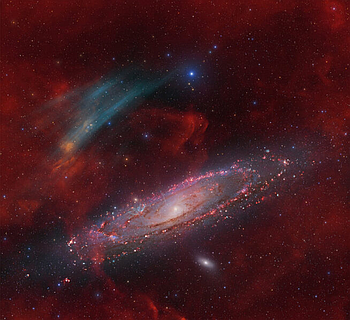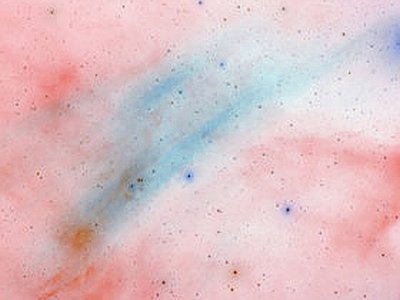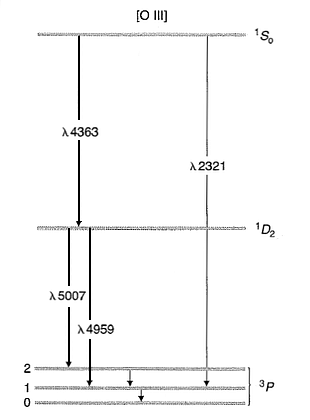
"Amateur Astronomers Find Glowing Gas Arc Near Andromeda"
(photo source: Sky & Telescope news, January 17, 2023)
[ Sky & Telescope news article ]
[ Hi-Res version
at NASA's Astronomy Picture of the Day ]
Photo by Yann Sainty and Marcel Drechsler.

Inverted and enlarged image of ionized
oxygen cloud next to Andromeda Galaxy.
Note added at the end of 2025: It's been almost 2 years since
the last research paper came out on what's been called SDSO-1, and since
it has appeared not to move any in position in the interim it's almost
certainly not either of artificial origin or very close to earth, as I
surmised. below. The pre-print is titled
SDSO1 is a
Ghost Planetary Nebula Bow Shock in Front of M31
WRT: "Discovery of Extensive [O III] Emission Near
M31" (January 2023)
by Marcel Drechsler, Xavier Strottner, Yann Sainty, Robert A. Fesen,
Stefan Kimeswenger, J. Michael Shull, Bray Falls, Christophe Vergnes,
Nicolas Martino, and Sean Walker.
[ Discovery of Extensive [O III] Emission Near M31 ]
The key piece of information in the above research report is the
non-detection of Hα emission from the nebula.

To an astronomer, 90% of the atoms in the universe are hydrogen,
10% are helium, and the remaining ~1% are everything else -- carbon,
oxygen, neon, iron, etc. (Yes, I know this adds up to more than 100%,
but I'm using very round numbers.) Wherever oxygen is found, hydrogen
is going to be much more abundantly present. If there's enough energy
to ionize oxygen twice there's also going to be enough to ionize
hydrogen, and Hα emission will naturally follow. But this
appears to be absent.
The conclusion that follows then is that the oxygen must be pure,
and thus it has to have an artificial origin. The oxygen lost by the
Apollo 13 mission on its way to the Moon more than fifty years ago
immediately springs to mind. The accident happened at 55:54:53 into
the mission, i.e., after launch (at 03:08 UTC on April 14, 1970;
10:08 PM EST, April 13. Maybe NASA or the other space agencies know
of other spacecraft that have vented significant amounts of oxygen
into space, but for now Apollo 13 would have to be the leading
contender. It lost about 620 pounds of liquid O2, or
5.46 x 1027 oxygen atoms (9,070 moles).
This then locates the gas within the solar system rather than at
the much larger distances people have thus far been considering.
The gas cloud's distance is likely on the order of a fraction of
an AU, depending on where along earth's orbit one is when looking
at it. The steady momentum imparted to the gas by the prolonged
small pressure from the solar wind would have moved it out of the
earth-moon system to beyond the earth's orbit.
The source of the gas's ionization, then, is not photo-ionization
from a star with a very hot surface, but kinetic ionization from
its interaction with the solar wind, sometimes called collisional
ionization. (The usual case here is an old supernova remnant
plowing into a stationary cold interstellar medium.) The slow
solar wind has proton velocities corresponding to ~1000 eV, which
is more than sufficient to break oxygen molecules apart and then
doubly ionize the resulting atoms. The first ionization energy
for O is virtually identical to that for H, 13.61 eV. It then
takes an additional 35.11 eV to knock a second electron off, for a
total just shy of 50 eV needed to make O-III out of atomic oxygen.
Depending on the efficiency one assumes for this process you could
get anywhere from several to a couple of dozen O-III ions per solar
wind proton (because those in the slow wind can have energies from
~500 eV up to about 1500 eV). I suppose even higher ionization
states (O-IV, O-V, etc) are feasible with this much energy per
particle slamming into the gas. To knock a third electron out, to
form O-IV, takes an additional 54.6 eV.
Somebody has probably at some time or another shot 500-1500 eV
protons into a fog of frozen O2 crystals in a vacuum,
but a literature search to track it down could take something on
the order of a Hubble time.
This second ionization energy (35+ eV) corresponds to a photon
wavelength of only 353Å (or lower) -- 10x shorter than the
UV photons that cause sunburn -- for the case of photo-ionization,
which only the hottest known stars and other objects in the universe
emit in any quantity.
Of course it's one thing to create the needed O++ ions,
but they also have to be excited properly to radiate the light seen.
In a regular emission nebula, like the Orion Nebula, the hard UV
photon energy in excess of what's needed to ionize hydrogen goes
into heating the resultant plasma, to about 10,000°K. At this
temperature the typical electron has an energy, kT, of ~1 eV. But,
because of the Maxwellian distribution of velocities and energies,
there are sufficient electrons with the higher ~2½ eV needed
to collisionally excite O++ ions from the ground state
up to the higher energy level from which they can radiate the
observed 5007Å emission line. (By contrast, hydrogen in the
ground state has no comparable low-lying energy levels, so it is
not similarly collisionally excited, and it is mostly ionized
anyway; the observed H emission lines result from free-bound
recombinations followed by subsequent cascading down towards the
ground state.) The relevant excited state of O++ from
which the 5007Å originates is relatively long-lived -- the
technical term is "meta-stable" and the radiation is said to be
"forbidden" -- so in dense enough or hot enough gas it can be
collisionally de-excited before a photon is emitted as
the ion drops back down to the ground state, or it can be raised
to an even higher energy level by another suitable collision.
It isn't clear in the case of the cloud under current discussion
which of these well-known processes is in operation, or even
relevant. The trace heavy elements like oxygen play no part in
the ionization equilibrium in a natural nebula, because of their
small numbers. They do however play an important role in the
thermal equilibrium because they absorb energy from the
hot gas and radiate it away from the nebula. So they mainly act
as coolants. A pure O++ gas cloud would seem to have
a difficult time staying hot enough to stay ionized. Perhaps the
solar wind protons can fill both roles, ionizing the gas and then
keeping it warm enough to radiate.
The difficulty with this scenario is that Apollo 13 was on almost
the exact "wrong" side of the Sun when the accident occurred. The
date was April 14 (Universal Time), and around that date the line
from the Earth (and the Earth-Moon system as well) to the Andromeda
Galaxy is nearly coincident with the line to the Sun, particularly
in longitude around the Earth's orbit, where the difference would
have been less than 4°. (Andromeda is then ~33 1/3° N of the plane
of the Earth's orbit.) So we'd need to get the expelled gas cloud
about 180° around the Earth's orbit before it left the earth-moon
system, to the opposite side from where the accident occurred, in
order for it to now appear almost in the direction of the Andromeda
Galaxy.
There are two different kinds of parallax measurements that could
test this hypothesis:
The first involves simultaneous measures made from two widely
separated locations. This is what was done to calibrate the
astronomical unit in regular distance units using a transit
of Venus back in the 18th century, where two widely separated
observers saw tracks of the planet across the sun that were
offset from one another as a result of their differing
perspective. If the measures of the nebula were made at
nearly the same longitude but at a latitude difference of
40° or 45°, the baseline might be of the order of
4,000 km. If the nebula was about ½ AU away at the time
(because the view may be across a good section of the earth's
orbit), or roughly 80 million kilometers, the displacement would
be on the order of 10 arc-seconds, or 5 pixels at the scale of
the instrument used to discover the nebula (as reported in the
research paper). Since the cloud has no real knots or hard edges
to serve as a reference, one might use cross correlation techniques
(after removing the stars) to put the two images in registration
on top of each other; one would then put the stars back in their
proper location and then look for a displacement of the stars in
the two images.
The other kind of parallax measurement would be sequential in
time from a fixed location, using the earth's orbital motion
to provide a changing perspective, reflected in the nebula
appearing to move relative to the background of stars. This
motion could conceivably already be present in the original
data obtained, though it would have been smeared out and lost
when all the images, taken over a period of several weeks, were
"stacked" (added together) to provide the final, ultra-long
exposure time picture that's been widely distributed.
One would need to be careful not to make the images to be used
near the two times in the year when the earth was heading almost
directly towards or away from the cloud. These would roughly
correspond to the stationary points in the retrograde motion
of an outer planet, where the apparent motion of the planet
stops before reversing direction. At about the time when the
Andromeda Galaxy was at opposition from the sun (around Oct 4),
the earth moves ~2.6 million kilometers per day, so for two
images taken a day apart that would be the baseline. At ½
AU to the cloud, the displacement would then be almost 2°
per day if the cloud was stationary in space, which would be
an obvious amount of motion. In actuality, of course, the cloud
would have started with about the same angular momentum as the
earth, and in an orbit just a little bit larger than earth's
would have nearly the same velocity. For an a=1.02 AU orbit the
average speed is 29.49 km/s rather than the 29.786 km/s for the
earth; the Δ-v works out to just 25,375 km per day relative
to the earth, but at only 1/50th of an AU this still works out
to ~¼° per day. That the research paper says the
confirming observations had the nebula at the same location
suggests the likelihood that if it's in the solar system it
would have to be much farther than a fraction of an AU away
for any motion to have escaped notice, though it's not specified
what time interval the original and confirming observations
were made over.
But one can never be sure. If for some reason the nebula is
no longer there the better fraction of a year later when people
go to look for it again, it could just be in a different place.
For that a=1.02 AU orbit, the period is ~11 days longer than our
year, so it would be "behind" us in getting around the sun by
something like 10-12°.
There's only one instance in the astronomical literature that
I know of where nearly pure oxygen is measured to exist: in a few
of the bright, fast-moving knots in the bright radio source Cas A,
a supernova remnant some 350 years old. The measurements suggest
the knots are surviving chunks from deep inside the progenitor
star, namely from near the base of the helium-burning shell,
where almost all the helium and carbon had been converted into
oxygen -- and maybe small amounts of a few other elements beyond,
like sulfur and neon.
This page currently under construction...
Notes
[ ecliptic long. ~27 1/2 for M31 vs. 23 2/3 for Sun, lat. ~33 1/3° ]
TLI 02:35:46
1st Midcourse correction 30:40:50, burn into hybrid trajectory for Fra Mauro
(~4½-5° S); 40,000 mi off earth's surface if nothing else done
O2 tank explosion 55:54:53, 210,000 mi from earth (84½% of max)
2nd course correction, back to a free return trajectory
61:29:43 (LM's Descent Propulsion System)
stars visible inside moon's shadow 76:42:07
"PC+2" burn; pericynthion + 2 hours TEI 79:27:38.95 (shortened return 12 hrs)
3rd DPS burn 105:18:42, projected entry flight path angle back within safe limits
full power-up of LM 133:00:00
4th LM burn 137:40:13, using reaction control thrusters
service module jettisoned ~138:02 "a considerable amount of debris visible"
undock from lunar module 141:30:00
re-entry 142:40:46
down 142:54:41
"Lovell, looking out the window, reported "a gas of some sort"
venting into space, making it clear that there was a serious
problem." ... "As soon as Lovell pressed his nose to the glass
[~10 minutes after the explosion], his eye caught a thin, white,
gassy cloud surrounding his craft, crystallizing on contact with
space, and forming an irridescent halo that extended tenuously
for miles in all directions." ...
"Tank one, however, was still in a slow leak. Its contents were
obviously streaming into space, and the force of the leak was no
doubt what was responsible for the out-of-control motion of the
ship [for more than an hour after the explosion]. It was nice
to know that when the needle finally reached zero Odyssey's
oscillations would at last disappear." ...
"It was almost as if some huge, gassy halo had surrounded the ship,
spreading out slowly for twenty-five or thirty miles [as seen
by Saulietes from a 14" telescope on the ground]." ... "The
volume surrounding the spacecraft was filled with myriad small
bits of debris from the accident, complicating any efforts to
use the stars for navigation." ...
"The view from the LEM [Lunar Excursion Module, aka the lunar
lander] was much the same as it had been from the Command Module:
a swirling cloud of oxygen ice crystals and particles of debris...
hundreds, indeed thousands, of brightly glowing false stars." ...
"Everywhere he [Lovell] looked out his window, the cloud of rubble
that surrounded Aquarius [the LEM] seemed uniformly dense. Firing
the jets to move straight forward, he tried to fly out of the the
glowing haze, but it seemed to move with him, almost as if the
gravitational attraction of the ships themselves -- with the
moon's or the Earth's gravity to compete with them -- was drawing
the rubbish particles along like iron filings moving with a magnet.
... Everywhere Lovell looked, his view of the distant stars was
obliterated. ... Aligning his [navigation] platform by the stars,
he was now convinced, would be impossible." This persisted until
after the PC+2 burn, except when they went into the shadow of the
Moon ~45 minutes before "PC" and could make out Antares and Nunki
(σ Sag) -- as well as the Milky Way, though there were two
"eerily dark columns blotting out some of the newly visible
stars"; this was ~24 hours after the explosion. Notice that the
recently discovered cloud has two main columns.
320 lbs of O2; density of LOX: 1,141 kilogram per cubic meter
at -183°C / ~boiling point (9.51 lbs/gallon => 33.7 gallons per tank).
860 psi initially, tank #1 loss rate was "better than a pound per
minute." 100 psi minimum needed by fuel cells. After O2 surge tank
was isolated (cut off), the rate was -1.7 lbs/minute, and increased
to ~3. It took ~2 hrs to drop to 205 psi, and a little less than
3 hrs before being empty.
spacecraft speed: ~2,000 mph = ~3,000 fps; back up to near 5,000
mph ~1 hr after astronauts went into LEM -- it was 3,000 mph
(4,400 fps) as the de-hybrid, docked DPS burn was being worked
out ~3 1/2 after accident, which only required a delta-v of 16 fps.
Wikipedia: The 10.7 cm radio flux (F10.7) is a measurement of RF
[radio frequency] emissions from the Sun and is roughly correlated
with the solar EUV flux. Since this RF emission is easily obtained
from the ground and EUV flux is not, this value has been measured
and disseminated continuously since 1947. The world standard
measurements are made by the Dominion Radio Astrophysical Observatory
at Penticton, BC, Canada and reported once a day at local noon in
solar flux units (10−22W·m−2·Hz−1). F10.7 is archived by the National
Geophysical Data Center.
Many of the early instruments were research spacecraft that were
re-purposed for space weather applications. One of the first of these
was the IMP-8 (Interplanetary Monitoring Platform).[57] It orbited the
Earth at 35 Earth radii and observed the solar wind for two-thirds of
its 12-day orbits from 1973 to 2006. Since the solar wind carries
disturbances that affect the magnetosphere and ionosphere, IMP-8
demonstrated the utility of continuous solar wind monitoring. IMP-8
was followed by ISEE-3, which was placed near the L1 Sun-Earth
Lagrangian point, 235 Earth radii above the surface (about 1.5 million
km, or 924,000 miles) and continuously monitored the solar wind from
1978 to 1982. The next spacecraft to monitor the solar wind at the L1
point was WIND from 1994 to 1998. After April 1998, the WIND spacecraft
orbit was changed to circle the Earth and occasionally pass the L1 point.
The NASA Advanced Composition Explorer (ACE) has monitored the solar wind
at the L1 point from 1997 to present.

©2023-25, Chris Wetherill. All rights reserved. Display of
words or photos here does NOT constitute or imply permission to store,
copy, republish, or redistribute my work in any manner for any
purpose without expressed prior permission.

Back to: Main VISNS Page




